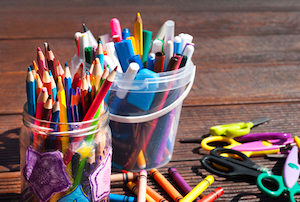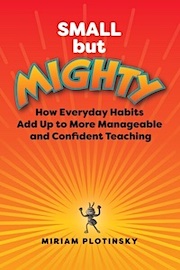9 Habit-Stacking Tips for Low-Key Summer Prep
By Miriam Plotinsky
 The existence known as “teacher life” varies from person to person, but one experience typically holds true across the board: the work is overwhelming.
The existence known as “teacher life” varies from person to person, but one experience typically holds true across the board: the work is overwhelming.
In the summertime the last thing anyone may want to think about is going back to school in the fall. A solid break from the grind is necessary from a mental health perspective, so it is therefore inadvisable to spend a lot of time ruminating about the upcoming year of instruction.
As a happy medium, the practice of what is known as “habit stacking” is a way to prepare for the upcoming school year without getting mired in the weeds.
Small moves toward important goals
Simply put, habit stacking is when we make small but powerful moves toward a goal in incremental steps, which works for adults and students alike. We then apply these smaller habits to our lives with consistency rather than trying to implement more dramatic shifts that might be harder to maintain.
To that end, the following habit stacks can set everyone up for success without taking away from the glory of summer break.
When it comes to building new habits, you can use the connectedness of behavior to your advantage. One of the best ways to build a new habit is to identify a current habit you already do each day and then stack your new behavior on top. This is called habit stacking. – Dr. James Clear
Habit Stack #1: Visualize the upcoming year.
Looking back on the school year we just finished might elicit anything from funny kid stories to cringeworthy memories. These momentary recollections aside, how much time does anyone typically spend engaging in a more profound reflection about how the coming year will differ from the previous one? A well-known adage advises that we should “be the change,” but first we need to visualize what that necessary change looks like.
The idea of making big shifts is daunting, but there is no need for drastic action. Instead, we can start the habit stacking process by finding both a chunk of time (say, 10 to 15 minutes) and a quiet spot where no interruption will occur. If desired, bring a notepad for jotting down a few thoughts, but try to disconnect from any devices.
Then, think about the answer to this question: What does a successful school year look like for me? Answers will vary for everyone. Consider the intersection of private and professional life, how to best balance personal wellness needs with the daily demands of teaching, and what might be non-negotiable or expendable.
The biggest consideration when visualizing a desired state of being is to set attainable goals only, and ones that you are likely to want to fulfill. For example, I might visualize a more orderly classroom space and then focus only on what an organized desk might look like. In other words, less is more in terms of making the highest positive impact with a reduction in stress.
Habit Stack #2: Identify specific, doable sanity savers.
After many years of working in schools, I became familiar with certain patterns that emerged from year to year. For example, I learned that if I was unable to take just a quick five-minute walk outside each day, my mindset would deteriorate, and little annoyances would start seeming like disasters. While I was unable to commit to a longer walk, I chose a more doable sanity saver, and this habit has stood the test of time to make even the most difficult days more manageable.
Everyone needs a little boost to get through the day, or what one of my colleagues jokingly refers to as a “joy snack.” Thankfully, stacking these little moments on top of one another is possible if we go about it with intention and consistency.
Whether it’s taking five minutes to talk to a friend each day, completing part of a crossword puzzle, playing an instrument, or finding a quiet spot for a coffee break without interruption, it is possible to preserve our sense of calm in small, meaningful ways. Before the school year begins, identifying just one or two as a start is a great first step. More than that might be difficult to stick with once the year gets rolling, which is why starting small is best.
Habit Stack #3: Prioritize one goal.
At the close of each school year, I have a laundry list of things I’d like to fix heading into the future. The problem is that if I try to achieve everything, I will become quickly overwhelmed and get nothing accomplished. There is nothing wrong with making a list of things we want to do to improve teaching and learning, but we must then build the habit of recognizing and then prioritizing the most important item.
If student work piles up each year, for example, a better organizational system is needed to keep that endless pile of papers under control. It’s about identifying priorities: is a poorly designed grading system the thing that is keeping me from being my best professional self, or is there something else that might be a bigger problem? If so, I can place my focus on measures for improvement, like assigning fewer tasks and developing a more efficient method of assessment, like the holistic sort.
However, it might be that a bigger issue is that each day starts off in a hectic whirlwind that makes it impossible to be effective in other areas. In that case, the grading issue is just a symptom of a larger problem, so energy should be put toward establishing a more productive morning routine.
Habit Stack #4: Reach out to a teaching buddy.
Teacher life just isn’t as rich without someone to share it with, and that person is usually an empathetic colleague. Everyone needs a trusted ally who has a realistic viewpoint without the tendency to become overly negative.
Before the school year starts, setting aside some social time with a work buddy we usually only see at more stressful moments is a more leisurely way to talk about anything that might be worrisome for the coming year. With time to interact without being interrupted, bouncing ideas off one another is a great way to get into the zone for taking next steps
Habit Stack #5: Note the good things.
When pressure starts to intensify in those early weeks of school, having a tangible reminder of the aspects of our lives that are going well helps to keep the energy flowing.
There is a robust body of research from esteemed organizations like the National Institutes of Health to support being mindful about recording our gratitude, so before things get hectic, take a few minutes to jot down some thoughts on what can be classified as the “good things” in life. These ideas can grow and expand throughout the school year if desired, but having a physical written record serves as an important reminder on tough days.
As a habit, it helps to put what you’ve written somewhere visible and accessible. For many people, taking a photo and being able to look at their “good things” on an available device might be most convenient. Another habit to stack on top of that is to reflect on what we’ve written in a quiet place. That way, we can take a deep breath and focus for just a moment before jumping back into the fray.
Habit Stack #6: Do some homework (but not too much).

Teaching is unpredictable, both in terms of interruptions on any given day and with the exact pacing of student progress. Therefore, a more ideal habit stack involves engaging in the first step of backward design with the identification of learning outcomes, but then minimizing how much we get into the weeds of planning out formative assessment measures and daily lessons.
There is nothing wrong with mapping out the first couple of weeks (a month at most), but that is all. Then August is not entirely taken up with work, and everyone is still positioned to start the school year off on a strong note.
Habit Stack #7: Learn names.
I teach a graduate course for teachers who are looking to build skills. One semester we got into a somewhat heated conversation about the importance of knowing the names of students early in the year after one participant said, “I can’t learn names. I’ve tried, but it’s too hard. It takes me a few months.”
I could tell that this statement was unacceptable to many people in the room, and I also felt strongly that learning names early in the year was important. As the teacher, however, I had to modulate my response so that this participant didn’t feel shut down, and so that we could think of strategies that would help them with this challenge.
After all, learning a lot of names can be very difficult for some individuals. Having said that, there are few bottom lines in teaching, but one of them is that we must know who the children in front of us are as quickly as possible. In the first week of school, learning everyone’s name is a habit stack that cannot be ignored.
These suggestions, which include taking photos or arranging name tents, can help anyone who understandably finds that much memorization to be daunting.
Habit Stack #8: Create friction for distraction.
It is stressful to think about classes we’ve taught in the past that have gone off the rails, and to therefore feel the need to make sure that it does not keep happening.
Students are often the cause of any disruption, but plenty of other factors can get in the way, like announcements being blared over the PA system or a sudden change in the daily schedule. Overhauling classroom management structures is an intimidating process, but smaller habit stacks can be just as effective for making sustainable change.
For example, unproductive habits can be changed with a concept known as “friction,” which occurs when we make it difficult to continue doing something that serves no good purpose. An illustration might be placing an unhealthy snack food on a high shelf that requires standing on a chair for access, which then prompts us to question whether it’s worth the trouble to get the food that we specifically wish to avoid.

Suppose students rely too heavily on devices, which is a pervasive problem in nearly all classrooms nowadays. We can add friction to this process by putting more work in non-digital spaces, and by having ways to keep technology out of sight for much of the time. That way, there is a physical barrier to being tech dependent with simultaneous access to alternate materials.
Habit Stack #9: Practice self-compassion.
It is human nature to be self-critical, and we tend to take that to extremes. Kindness gets a lot of airtime in our culture, but we might want to dig a little deeper into the concept of compassion. While compassion might be defined in a variety of ways, one of the essential tenets is treating ourselves as we would others. If someone’s inner feelings about themselves are harsh or unforgiving, that is likely not how they treat other people, which creates a double standard for behavior.
In teaching, practicing self-compassion requires that we embrace mistakes as a necessary step in the pathway to growth. On any given day, even the most well-planned lesson can fail spectacularly, leaving feelings of inadequacy in its wake. At times like this, it is so important to remember that without trying new things in class and remaining agile, we cannot become better teachers.
In addition, pushing ourselves toward burnout because of what we perceive we “should” be doing burns the candle at both ends to the point that many teachers wind up leaving the profession entirely. Therefore, setting limits on working during the time spent outside of school is a small but important habit to enforce for the sake of not just being compassionate toward ourselves, but also for remaining in the profession.
Start habit-stacking this summer
Ultimately, feeling fully prepared for the upcoming school year is not necessarily the goal to shoot for. Instead, taking advantage of small moments throughout the summer to upgrade our professional and personal lives through habit stacking is a far more doable proposition. That way, it is possible to ease gradually into the autumn months with purpose, not panic.
Miriam Plotinsky is an instructional specialist with Montgomery County (MD) Public Schools and the author of Writing Their Future Selves: Instructional Strategies to Affirm Student Identity (WW Norton, 2023), Lead Like a Teacher: How to Elevate Expertise in Your School (WW Norton, 2023), and Teach More, Hover Less: How to Stop Micromanaging Your Secondary Classroom (WW Norton, 2022).

Miriam is also a National Board Certified Teacher and certified administrator and lives in Silver Spring, Maryland. Her articles have appeared at MiddleWeb, Edutopia, ASCD Express, Education Week, EdSurge and other outlets. Visit her website and follow her on X/Twitter @MirPloMCPS.
Planning image by Megan Rexazin Conde from Pixabay































